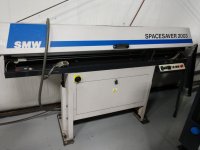Hi all,
I have a new (used) lathe coming in to the shop soon that I would like to put a short bar loader on to load 4' bars. I have a LNS QuickLoad on another lathe that works great. The problem is that the new machine has a spindle that is only about 38" long. It is my understanding that you cannot use short bar loaders to load bars that are longer than the spindle length.
So what are my options? Cutting the bars into four 3' chunks is not something I'd like to do. Has anyone had any success with making a spindle extension that will allow a 4' bar to be loaded into a shorter spindle? Any other way around this?
Thanks!
I have a new (used) lathe coming in to the shop soon that I would like to put a short bar loader on to load 4' bars. I have a LNS QuickLoad on another lathe that works great. The problem is that the new machine has a spindle that is only about 38" long. It is my understanding that you cannot use short bar loaders to load bars that are longer than the spindle length.
So what are my options? Cutting the bars into four 3' chunks is not something I'd like to do. Has anyone had any success with making a spindle extension that will allow a 4' bar to be loaded into a shorter spindle? Any other way around this?
Thanks!



